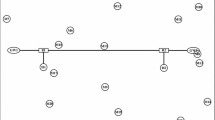Abstract
The analysis of traffic characteristics can be used for performance evaluation, design and implementation of routing protocols in WMNs (Wireless Mesh Networks). Higher bursty traffic will cause larger queue size, which means more dropping packets, and thus affects other metrics. Because burstiness can be modeled by multi-fractal characteristics effectively, multi-fractal characteristics of mobile node’s traffic in WMNs are analyzed with typical proactive and reactive routing protocols, which are DSDV (Destination Sequenced Distance Vector) and AODV (Ad hoc On-demand Distance Vector), respectively. Three types of traffic models are used to generate traffic at application level, which corresponding to open-loop and closed-loop scenarios. With different configurations, the probability distribution of inter-arrival time and multi-fractal characteristics of traffic at mobile node and gateway are analyzed with DSDV and AODV protocols. Results show that inter-arrival time with AODV and DSDV protocols possesses heavy-tailed property. And traffic with DSDV protocol exhibits more multi-fractal characteristics than that with AODV protocol, which can explain the higher routing performance of AODV.
Similar content being viewed by others
References
Boukerche A. (2004) Performance evaluation of routing protocols for ad hoc wireless networks. Mobile Networks and Applications 9(4): 333–342
Perkins, C. E., & Bhagwat, P. (1994). Highly dynamic destination-sequenced distance-vector routing (DSDV) for mobile computers. In Proceedings of the conference on communications architectures, protocols and applications (SIGCOMM’94) (pp. 234–244). London, UK.
Perkins, C. E., Royer, E. M., & Das, S. R. (1999). Ad hoc on demand distance vector routing. From http://www.ietf.org/internet-drafts/draft-ietf-manetaodv-03.txt.
Ren W., Yeung D. Y., Jin H. (2006) TCP performance evaluation over AODV and DSDV in RW and SN mobility models. Journal of Zhejiang University: Science 7(10): 1683–1689
Abry P., Baraniuk R., Flandrin P., Riedi R., Veitch D. (2002) The multiscale nature of network traffic: Discovery, analysis, and modeling. IEEE Signal Processing Magazine 19(3): 28–46
Leland W. E., Willinger W., Taqqu M. S., Wilson D. V. (1995) On the self-similar nature of ethernet traffic. Computer Communication Review 25(1): 202–213
Crovella M. E., Bestavros A. (1997) Self-similarity in world wide web traffic: Evidence and possible causes. IEEE/ACM Transactions on Networking 5(6): 835–846
Levy, V. J., & Sikdar, B. (2001). A multiplicative multifractal model for TCP traffic. In Proceedings of sixth IEEE symposium on computers and communications (pp. 714–719). Hammamet, Tunisia.
Feldmann A., Gilbert A. C., Willinger W. (1998) Data networks as cascades: Investigating the multifractal nature of internet WAN traffic. Computer Communication Review 28(4): 42–55
Liang Q. L. (2002) Ad hoc wireless network traffic-self-similarity and forecasting. IEEE Communications Letters 6(7): 297–299
Yin, S. Y., & Lin, X. K. (2005). Traffic self-similarity in mobile Ad hoc net-works. In Proceedings of international conference on wireless and optical communications networks (pp. 285–289). United Arab Emirates: Dubai.
Tickoo O., Sikdar B. (2003) On the impact of IEEE 802.11 MAC on traffic characteristics. IEEE Journal on Selected Areas in Communications 21(2): 189–203
Pezaros, D. P., Sifalakis, M., & Hutchison, D. (2007). Measurement and analysis of intraflow performance characteristics of wireless traffic. In Proceedings of seventh IEEE workshop on IP operations and management (pp. 143–155). San José, CA, USA.
Riedi H.R. (2003) Multifractal processes. In: Doukhan P., Oppenheim G., Taqqu M.S (eds) Theory and applications of long-range dependence. Birkhäuser, Boston, pp 625–715
Riedi, H. R. (1999). Introduction to multifractals. Rice University Technical Report.
Sun X., Chen H. P., Wu Z. Q., Yuan Y. Z. (2001) Multifractal analysis of Hang Seng index in Hong Kong stock market. Physica A: Statistical Mechanics and its Applications 291(1–4): 553–562
Riedi R. H., Crouse M. S., Ribeiro V. J., Baraniuk R. G. (1999) A multi-fractal wavelet model with application to network traffic. IEEE Transactions on Information Theory 45(4): 992–1018
Ribeiro, V. J., Riedi, R. H., Crouse, M. S., & Baraniuk, R. G. (2000). Multiscale queuing analysis of long-range-dependent network traffic. In Proceedings of INFOCOM’00—19th annual joint conference of the IEEE computer and communications societies (pp. 1026–1035). Tel Aviv, Israel.
Liu, N. X. (2003). Statistical modeling and performance analysis of multi-scale traffic. In Proceedings of INFOCOM’03—22th annual joint conference of the IEEE computer and communications societies (pp. 1837–1847). San Francisco California, USA.
Ribeiro V. J., Riedi R. H., Baraniuk R. G. (2006) Multiscale queueing analysis. IEEE/ACM Transactions on Networking 14(5): 1005–1018
Teymori S., Zhuang W. H. (2007) Queue analysis and multiplexing of heavy-tailed traffic in wireless packet data networks. Mobile Networks and Applications 12(1): 31–41
Sikdar, B., Chandrayana, K., Vastola, K. S., & Kalyanaraman, S. (2002). On reducing the degree of second-order scaling in network traffic. In Proceedings of the GLOBECOM’02—IEEE global telecommunications conference (pp. 2594–2598). Taipei, Taiwan.
Doi H., Matsuda T., Yamamoto M. (2007) Influence of TCP congestion control on multifractal nature of network traffic. Electronics and Communications in Japan, Part I: Communications (English translation of Denshi Tsushin Gakkai Ronbunshi) 90(1): 68–76
VINT Project. (2008). The NS manual. From http://www.isi.edu/nsnam/ns/doc/ns_doc.pdf.
Hamidian, A. (2003). A study of internet connectivity for mobile ad hoc networks in NS 2. Master thesis, Faculty of Engineering LTH.
FracLab. (2007). Fraclab v2.04. From http://fraclab.saclay.inria.fr/news.html.
Marina, M. K., & Das, S. R. (2001). On-demand multipath distance vector routing in Ad Hoc networks. Proceedings of 9th international conference on network protocols (pp. 14–23).
Author information
Authors and Affiliations
Corresponding author
Rights and permissions
About this article
Cite this article
Chen, Y., Xiang, Z., Dong, Y. et al. Multi-Fractal Characteristics of Mobile Node’s Traffic in Wireless Mesh Network with AODV and DSDV Routing Protocols. Wireless Pers Commun 58, 741–757 (2011). https://doi.org/10.1007/s11277-009-9904-z
Published:
Issue Date:
DOI: https://doi.org/10.1007/s11277-009-9904-z




